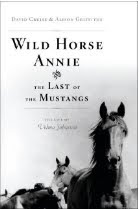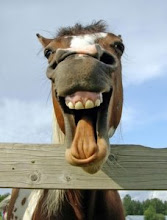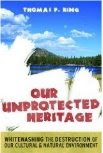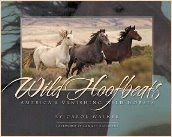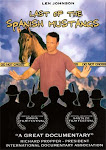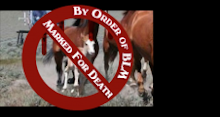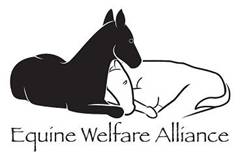 While Madeline Pickens has been searching for a plan to rescue America's wild horses and burros, another plan has recently surfaced from the newly elected Wyoming State Representative, Sue Wallis.
While Madeline Pickens has been searching for a plan to rescue America's wild horses and burros, another plan has recently surfaced from the newly elected Wyoming State Representative, Sue Wallis.In December 2008, The Horse Industry Policy, a resolution submitted by Rep. Wallis to the states National Conference of State Legislators (NCSL) was passed after a vote session from the members of state legislators from all 50 U.S. states. The main focus of the resolution is to urge Congress not to pass federal legislation that would prohibit horse slaughter in the U.S. or interfere in the transport or export of horses to slaughter.
Prior to submitting her resolution of the Horse Industry Policy to the NCSL, Rep. Wallis first enlisted the aid of pro-slaughter state horse councils by asking them to provide letters showing their support for the return of horse slaughter in the U.S. These were then presented to the NCSL to substantiate the position that horse slaughter has broad based support in equine communities nationwide.
In case you are wondering what the heck the NCSL is, it is a self-described non-profit tax-exempt 501(c) 3 corporation that raises money to support the objectives and special projects of the States. Their mission statement includes, “…offers opportunities for business, national associations and unions seeking to improve the state legislative process and enhance NCSL’s services to all legislatures.” My guess is this is a generalized way of saying they are a lobbying firm that lobbies federal officials on behalf of state special interests.
While Wallis's plan for America's wild horses and burros is not revealed in the resolutions of The Horse Industry Policy, the first hint of what her intentions are behind the scenes begins to unfold with Wallis thanking the man she claimed was "instrumental" in getting the resolution passed, Conrad Burns.
Burns, a lobbyist who promotes the horse slaughter industry, is a former U.S. Senator from Montana responsible for sneaking an 11th hour amendment into the 2004 Agriculture Appropriations bill without review or a vote by either the people or Congress that was quickly signed into law by President Bush. The Burns Rider, as it became known, gutted almost forty years of wild horse and burro protections and now mandated their “unconditional sale until all excess horses had been disposed of”, including authorizing their sale for slaughter.
Even though his method to pass his legislation was both unethical and immoral, it was considered a triumph by the minority of elite public resource users who have long wanted wild horses and burros removed in favor of what they consider more profitable uses of public lands.
In addition to Rep. Wallis’s close relationship and mentoring by former Senator Conrad Burns, she has also began working with former Rep. Charles Stenholm, a lobbyist and spokesperson for the former Texas horse slaughtering facilities. It was this team that began coordinating what can only be described as full scale blitz to promote the return of horse slaughter facilities in the U.S.
Although the BLM has yet to implement the slaughter option granted by the Burns Rider, over the last eight years they have removed almost 80,000 wild horses and burros throughout the West, despite holding facilities being at or over capacity for several of those years.
As BLM has continued to pursue this irresponsible course of action (which has lacked any real accountability or oversight along the way), the inevitable consequences finally set the stage for their announcement last summer that they are now considering the option of killing or selling for slaughter those wild horses and burros currently held in the overflowing facilities - as well as all those BLM deems "excessive" in the future - in order to relieve their financial pressures.
Due to these aggressive removal policies, today there are over 33,000 wild horses now being warehoused in government pens and even BLM admits there are more horses in facilities than roaming free on the range.
While BLM has been busy creating this backlog of wild horses and burros and the eyes of the Nation have sat complacently waiting for Madeleine Pickens to single handedly save them from what many consider years of bungled management, hidden behind Wallis's Horse Industry Policy to slaughter America’s domestic horses is also several documents extolling the virtues of using this backlog of mustangs and burros to feed the worlds poor and hungry.
As Rep. Wallis parrots propaganda demanding “fiscal responsibility and accountability” through Power Point presentations highlighting how the selling of mustang meat to foreign countries is an appropriate way to solve BLMs financial crisis, she shows little interest in investigating the real root of the problem; specifically, she’s not interested in investigating the BLM for potential waste, fraud and abuse or possible legal violations within the Wild Horse & Burro Program itself. Instead, her focus is on grinding up the evidence under the guise of curing the worlds hunger problem – a gift from America wrapped in a cloak of benevolence to those who can’t afford to purchase meat.
In case you are wondering why Ms. Wallis is targeting only wild free-roaming mustangs and burros to feed to the poor, it’s because American horse meat is not subjected to the same standards other animals raised for agricultural food use are. Consequently, it’s only mustang meat that can be shared with the world “ethically” as it has not been tainted with hazardous-to-human drugs domestic horses are given here on a routine basis.
Here’s one of the ways Rep. Wallis pitches mustang meat patties in #9 of her talking points: “Remind them that 10 million people starve to death every year in this world…maybe our excess BLM wild horses could be put to much better use by providing high quality, nutritious animal protein, untainted by BSE-type disease concerns of other livestock to people who could never afford to buy it. Once again, Americans can use an abundant and sustainable resource to come to the aid of the poor and starving of the world.”
While making self-proclamations that her moral, ethical and compassionate cup overflows with humane considerations tempered only by “common sense”, notice how she sidesteps the fact it’s only the high-end foreign markets her new Horse Industry Policy aims to cater to at $25.00 per/lb.
It’s also interesting to note that Rep. Wallis finds nothing ethically wrong with sending the tainted domestic horsemeat to foreign consumers, it’s only the world’s poor she is concerned with feeding “high quality” meat too, which raises the question….If they are successful in getting horse slaughter reinstated in the U.S., will they build separate processing facilities - one for “organically raised free-roaming” wild horse and burro meat for the poor and one for industrial/agriculture drug filled race and quarter horses marked as “For French Consumption Only”?
State legislators from several states have now introduced resolutions based on her leadership urging federal legislators to not interfere with state rights by prohibiting horse slaughter in the U.S. or interfere with the transport and export of horses to slaughter. A few states have even passed legislation that allows for funding of feasibility studies on horse slaughter facilities in their state. Does anyone have any doubt what the outcome of these studies will be, studies that will then be used to substantiate an already forgone conclusion that “slaughtering America’s horses is good for business”?
Representative Wallis, who appears to be little more than a modern day mustanger in elected official clothing, has also begun a letter writing campaign kicked off in an Open Letter to the United States Congress and State Legislators. (See links below.)
It was this letter that revealed what she has really has in mind for America’s wild horses and burros, as well as her reasons for promoting a horsemeat market here in the U.S., a policy which includes allowing immigrant cultures the right to buy horsemeat right here at home.
Apparently, Ms. Wallis believes the tainted “nutritious” meat is also good enough for some Americans too - just as long as it’s only fed to the immigrant populations! (Or do you think mad cow’s disease is really a lot worse than they are telling us about and our own upper class is now angling to secure a new non-infected meat while still feeding beef, the real root of the world’s hunger problem, to the unsuspecting majority?)
Since I’m on the subject, pardon me if I digress a moment but there are some side notes about Rep. Wallis’s arguments I feel compelled to address. (Okay, there's actually a ton of her points I’d like to address but there’s just not enough space for them all!)
One of her arguments urging the continuation of horse slaughter is based on the far-fetched illogical assumption that caring for America’s horses as companion animals like we do for our dogs and cats is really a plot aimed at shutting down the beef industry.
Since American’s don’t eat horsemeat (and haven’t for a very long time), I’m going to make the same far-fetched illogical assumption that her promotion of horsemeat to benefit the immigrant cultures of America and abroad will soon include her support of dog and cat harvesting factories to please them as well.
When discussing the effects of banning horse slaughter in her letter to Congress, Rep. Wallis states, “…and especially how devastating economically, and socially, this has been to the admittedly small population of the country, like myself and my family and neighbors, who still make our living from animal agriculture”.
Though she admits she is a “small part of the country’s population”, she simultaneously insists the majority of the nation must be forced to tolerate this inhumane practice for the benefit of these few. Yet in classic hypocritical fashion, she is equally defiant at the thought of the majority of American’s who oppose horse slaughter (she calls them a “small group of radical animal rights activists”) now starting to stand up and demand this “small population” stop forcing our nation's horses to be subjected to such a brutal and inhumane deaths for their exclusive benefit and those outside our borders.
She also goes on to say that those who deny immigrant cultures the right to access horsemeat in America are “incredibly arrogant”. Thus, it would appear Rep. Wallis is again in the minority by standing with those who believe American’s should change our values to accommodate every culture who joins our melting pot versus the majority who believe those we welcome into our nation’s fold swear allegiance to our way of life, not theirs.
But back to the immediate issues at hand, Rep. Wallis, being the industrious gal that she is, has also been busy organizing and calling on a huge network of groups to follow her plan of action to bring horse slaughter back to the U.S. Some of these include the entire agriculture industry, horse-breeding organizations, rodeo and other horse industry associations including the American Quarter Horse Association (AQHA). It also includes a full scale media blitz urging everyone in the network to write newspapers and submit opinion letters based on the talking points she has assembled to support her “humane but practical” plans.
As for the Wallis’s themselves, she and hubby Rod raise grassfat natural beef on the family ranch north of Recluse, WY with Mom & Pop Myrt and Dick and brother Frank, who also lives on the ranch but he raises Belgian and Haflinger horses instead.
Currently, we can only speculate as to why Rep. Wallis has decided to enter into the promotion of the horse-to-slaughter trade with mustangs on the side with such frenzied enthusiasm (perhaps she was tapped by former Senator Burns?)
Though Rep. Wallis attributes raising horses to the other side of the family, in her pro-slaughter talking points she examines how if the ban to transport horses for slaughter is passed, USDA officials will then be authorized “to inspect horses being transported anywhere”. She then goes on to say “…what a horrific imposition is just about to be foisted upon all of agriculture. If they can do this to me…let me assure you that we are one hair-breadth away from telling a diary man that he can no longer market his cows…” And just what exactly does Rep. Wallis mean “if they can do this to me” when she claims she raises cattle?
What makes this all the more irrational is when Rep. Wallis discusses the over 900 pages of violations found in the horse slaughter industry recently released by the USDA depicting hundreds of photos of horrific and brutal transport and slaughter practices, Ms. Wallis switches sides and states these only show the USDA was clearly doing their job by documenting the abuse. So this begs the question to Rancher Wallis, what part of USDA inspections do you consider an “imposition” to you and/or the agricultural community?
Throughout the Wallis literature and references, she makes various claims almost too stupendous to believe. Whether it is accusing those who have been exposing the dirty little secrets of the horse slaughter trade as exaggerating and fabricating evidence (like the USDA photos), attempting to re-brand the majority of American’s who advocate humane treatment for horses as “radical animal rights activists” or repeatedly issuing a hysterical battle cry that the demand for humane and ethical treatment of America’s horses is really a conspiratorial plot by a handful of Vegan’s, her surreal but all too real campaign to target the return of horse slaughter to America, now with the added bonus of BLM mustang meat patties, is no laughing matter.
Like the toned down but still despicable character Cruella DeVille in Disney’s 101 Dalmations, Ms. Wallis seems to be willing to go to any lengths to protect what she perceives to be her “beautiful coat”.
Whether you care about wild horses and burros or about how all horses are treated in America, you need to educate yourself NOW about Cruellas fast track to slaughter currently barreling at light speed through a multitude of state legislations and heading straight for your Congressional representative.
Wake up and smell the horsemeat…
Links to Representative Wallis Horsemeat Campaigns
Wallis’s Open Letter To Congress and State Legislators
NCSL – Power Point Presentation
Includes BLM statistics to support mustang and burro slaughter.
BLM Horses – Ashton Graham, New Mexico State Graduate Paper
Referenced by Rep. Wallis as support for mustang and burro slaughter.
WyoAg Coalition – Nation-wide Horse Industry Effort
Includes many links to pro-horse slaughter support efforts.
American Traditional Beef on HR 503
Cindy Schonholtz – PRCA Livestock Welfare
Includes Talking Points From WY State Representative Sue Wallis
Rodeo Attitude News – NCSL Supports the Horse Industry
A personal message from Cindy Meyers, CEO, Rodeo Attitude
Letter from ex Mayor Paula Bacon on Dallas Crown
What life is like after making a deal with the devil…
States Currently Pursuing Pro-Horse Slaughter Bills/Resolutions
Twelve State legislatures are now considering measures to express their support of or actively encourage the reestablishment of U.S. horse processing plants based on the Wallis Horse Industry Policy.
Arizona (SCM 1001)
A resolution urging Congress to oppose federal legislation that interferes with a state’s ability to direct the transport or processing of horses.
Arkansas (HCR 1004)
A resolution urging Congress to support the continuation of horse processing facilities in the United States.
Illinois (HB 0583)
A bill to repeal the state’s ban on the slaughter of horses for human consupmtion.
(ILHR 160) A resolution calling for the defeat of the pending federal anti-slaughter bill, HR 503.
Kansas (HCR 5004)
A resolution urging Congress to oppose federal legislation that interferes with a state’s ability to direct the transport or processing of horses. The state’s House Agriculture and Natural Resource Committee sent the bill to the full House for a vote.
Minnesota (SF 133)
A resolution urging Congress to oppose federal legislation that interferes with a state’s ability to direct the transport or processing of horses.
Missouri (HCR19)
A resolution urging Congress to oppose federal legislation that interferes with a state’s ability to direct the transport or processing of horses.
(SCR 8) – Unofficial Resolution
Includes references to competition in horse market with adoption market of 32,000 wild horses.
Montana (HB418)
A bill allowing a horse slaughter facility to operate in Montana that includes language prohibiting court action against a facility for filing for a permit, construction or operation of the facility. Already approved by Montana’s House and Senate and is currently awaiting Governor Schweitzer’s veto or approval.
North Dakota (HB 1496)
A bill directing the state’s Department of Commerce to conduct an equine processing facility feasibility study.
South Dakota (SCR2)
A resolution urging the reinstatement and funding of a federal inspection program governing horse slaughter and euthanasia facilities.
(SB 114) To provide for a study on the feasibility of establishing an equine processing facility and to make an appropriation for funding.
Tennessee (HB1361)
As introduced, deletes packaging and labeling requirements for horsemeat.
Utah (HJR7)
A resolution urging Congress to oppose federal legislation that interferes with a state’s ability to direct the transport or processing of horses. As of February 17, 2009, the Utah resolution has passed through the state House and Senate and had been sent to the lieutenant governor for enrollment.
Wyoming (HJR 0008)
A resolution urging Congress to oppose federal legislation that interferes with a state’s ability to direct the transport or processing of horses.
To learn more about the National Conference of State Legislatures (NCSL), Click Here.
And, how can I possibly explain
that racing horseback
loose and wild through
treacherous enchanting terrain,
sail loops from
rope swung, weary shoulders
to catch wily mustang mares
is the most exciting,
and addicting occupation
known to
woman
kind.
How Can I Explain
Poetry by Sue Wallis
May this raw land smell no more blood
or smother screams
of sundered souls.
Isolation Incantation
Poetry from Sue Wallis Represenative Wallis College is just another photo created by a non-radical non-vegan designed to inflame passions, manipulate USDA images, and fabricate the obviously non-existent atrocities of horse slaughter in order to achieve the purpose of making absolutely no money whatsoever and who is solely compelled by conscience.
Mustang Meat photo courtesy of Terry Watt-American Horse Defense Fund






